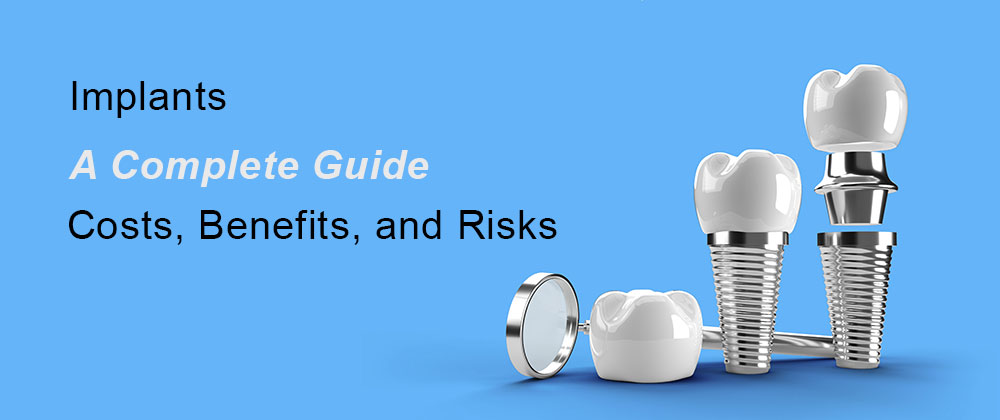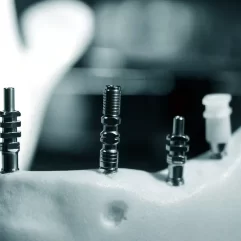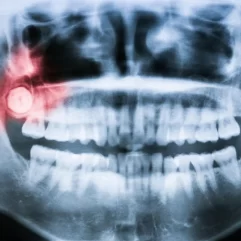Dental Implants: What You Need to Know
Understanding Dental Implants, Benefits, Costs, and Risks
Welcome to our detailed guide on different types of endosteal dental implants, also called a single implant. Whether you are considering getting dental implants or want to learn more about them, this blog post is packed with valuable information to help you make informed decisions. This article explains the basic structure and parts of the implant, how much dental implants cost, who needs implants, the risks, bone grafting for implants, and important considerations for a successful dental implant procedure.
We will delve deeper into dental implant types, the various types available, their benefits, potential costs, and more in our post Dental Implant Types.
Implants are a popular option for replacing missing teeth. These implants are surgically placed in the jawbone, providing a solid foundation for artificial teeth. If you are missing one or more teeth, implants may be a great choice to restore your smile and improve oral health. An implant is surgically placed into the jawbone as a foundation for artificial teeth. Implants consist of a metal post (usually made of titanium) implanted into the jawbone, fusing with the bone over time.
Once the implant has fully integrated with the bone, an artificial tooth or crown can be securely attached to the top of the implant, providing a long-lasting and natural-looking solution for missing teeth.
To delve deeper into other implant options, such as All-on-4s, implant-supported fixed bridges, and snap-on dentures, please read the blog post All-on-4’s Permanent Bridges. If you are considering going to Mexico for an Implant procedure, please read our blog on All-on-4 Dental Implants: US vs Mexico – Which is the Best Choice?
What are the Structure and Parts of Implants?

The building blocks of a beautiful smile: The components of Endosteal implants for seamless integration and lasting dental restorations.
Endosteal implants are cylindrical posts inserted into the jawbone at the gum line that replace the root of missing teeth and serve as the base for a replacement tooth. The procedure allows the replacement of natural teeth with a crown or bridge.
Using an artificial material such as titanium, the dental implant can bond to the bone below the gum line and form a site for a dental substitute to be attached. It typically takes four to six months for a dental implant to bond to the bone, and only then can the restoration tooth be attached. Once implants are placed, the body naturally tends to “osseointegrate” or accept and bond the Endosteal implants to the bone in preparation for a dental crown, a bridge, or a denture.
A small connector called an abutment is placed on the implants to facilitate the attachment of replacement teeth once healing and bonding are complete. The abutment is attached to the implant and serves as the base for the prosthetic dental component, which is then either cemented or screwed in for its final placement.
To make the new tooth (or teeth), the doctor takes impressions of our natural teeth and then uses that to determine the shape and placement of the replacement tooth.
What are the Benefits of Implants?
Implants can be used for a single tooth or multiple teeth or as a structure to attach dentures. Implants are more durable and can improve appearance, help speech, increase comfort, help chewing and digestion, and improve oral health.
While natural teeth are susceptible to decay, leading to root canals and other dental interventions, dental implants are metal and do not decay or need root canals. The dental implant procedure usually takes two or three visits.
In some areas in the US, Endosteal implants can be expensive. For example, a survey of dental implant types in New Mexico revealed prices ranging from $2,000.00 to $5,000.00 (excluding abutments and crowns). As a result, patients seeking affordable dental implant options are considering other destinations such as Mexico, including popular vacation spots like Mexico City, Cancun, and Playa del Carmen. There are options for finding various dental implant types near border states like Texas, Arizona, and New Mexico that are safe and high-quality, provided you know which dental clinic to visit.
Visit our Mexico Dental Tourism page to learn about all the locations in Mexico where we have vetted dental clinics.
How Much Do Dental Implants Cost?

Most people save 50% or more when they go to Mexico for dental work!
It is difficult to say with precision what Endosteal implants cost. In general, prices are based on the dental clinic location, what’s included in the procedure (besides the implant), the quality of the material, and other factors such as special offers.
As mentioned earlier, no two patients are exactly alike, and the cost, number of appointments, and approach to restoration can vary. According to realself.com, an online website that makes doctors available for questions, costs for various dental implant types can be up to $4,000.00. Still, other websites, such as perio.org, quote the cost of some Endosteal implants as high as $7,500.00 when the crown is included.
People needing several teeth replaced with dental implants may face hefty costs, so they often look for cheap dental implants.
In recent years, thousands have turned to dental tourism to find affordable dental implants. With the emergence of dental tourism companies like Beyond Borders Dental, people have access to high-quality, low-cost dental implants in Mexico. Most dental implant types in Mexico can be up to 75% cheaper than in the US.
People often ask why dental implant types in Mexico are much less expensive than in the US. Does this mean the quality is lower or the materials are inferior? This is not the case. Dentists in Mexico use the same materials and products in American dental offices. A Washington, DC-based health advocacy group found that 90% of people receiving treatment in Mexico rated their experience either “good” or “excellent.” That matched satisfaction with American dentists.
Less expensive dental implant types in Mexico are also the result of a Mexican education system that allows dentists to receive subsidized or free education in return for community service upon graduation. So dentists in Mexico do not leave school with $150,000.00 to $200,000.00 in student loans to repay as American dentists do. In addition, both rents and staff are much less expensive for dentists in Mexico. While dentists may earn upwards of $150,000.00 a year in the US, Mexican dentists generally earn $30,000.00 to $50,000.00, making affordable dental implants with the same quality as American dentists available.
Dental insurance doesn’t generally cover dental implants, although some reports suggest coverage may be available through a patient’s medical plan. However, affordable dental work in Mexico usually saves people more money than getting implants in the US, even with insurance coverage.
Who Needs Dental Implants and What Are the Risks?
Anyone who has lost one or more teeth may be a candidate for dental implants. When a tooth is lost, the alveolar bone (the sac-like bone structure that holds the natural teeth) begins to deteriorate. In time, even the basal bone beneath the alveolar bone, “the jawbone itself,” begins to disappear. Excessive bone loss causes various aesthetic and functional problems that can be treated using the proper dental implant type. High-quality dental implant types can stop this process and preserve the remaining bone structure.

Embracing the path to renewal: A journey begins when you courageously face dental challenges and reclaim a healthy smile.
However, as WebMD Oral Health Guide notes, patients should have healthy gums to accept the dental implant, which usually means a reasonable home dental health regimen has been followed. People who are heavy smokers or who have chronic health challenges such as diabetes, heart disease, or cancer (especially if they’ve received radiation to the head) need to be evaluated on a case-by-case basis.
Although not often, complications can arise from dental implants. These can include nerve injury, infection, and failure of the implant to bond to the bone. However, depending on where the dental implants are placed and personal habits of tobacco chewing, smoking, and home care, most dental implant types will last a lifetime, with success rates up to 98%, according to a WebMD Oral Health Guide article.
Patients receiving quality dental implants report little pain or discomfort associated with the procedure, and in most cases, a mild pain reliever such as Motrin is usually adequate. No two cases are the same, so our Mexican dentist will carefully assess your needs and can provide affordable dental implants in Mexico.
What is Bone Grafting for Dental Implants?
Bone grafting for dental implants is a standard surgical procedure used to increase the volume or density of the jawbone in preparation for dental implant placement. When a tooth is lost or extracted, the surrounding bone can resorb or deteriorate over time, leading to a loss of bone mass and density in that area. This can create challenges for successfully placing dental implants, as the implants need a certain amount of healthy bone to fuse and integrate with the jaw securely.
During a bone grafting procedure, a dentist or oral surgeon will take bone graft material (either from the patient’s body, a donor, or a synthetic source) and place it in the jaw area where bone volume needs to be increased. This graft material is a scaffold or framework for new bone growth, stimulating the body’s natural healing process to generate new bone tissue.
Once the bone graft has integrated and the jawbone has healed and strengthened, the patient can proceed with dental implant placement. The success of dental implants relies on having enough healthy bones to support and stabilize them long-term. Bone grafting can significantly improve the chances of a successful dental implant procedure, restoring the patient’s functionality, aesthetics, and overall oral health.
For bone grafting, bone comes from four different sources:
Autograft:
An autograft is a surgical procedure in which tissue or bone is removed from one part of a patient’s body and transplanted to another part within the same individual. This is often done to replace missing or damaged tissue in the mouth, such as bone grafts to strengthen the jawbone before dental implant placement.
Using an auto-graft ensures that the body does not reject the transplant material, as it is taken directly from the patient’s body. This can help promote faster healing and reduce the risk of complications following a dental procedure. Auto-grafts are commonly used in oral surgery to improve the success rate of various treatments and procedures.
Allograft:
An allograft is a surgical procedure where tissue or bone is taken from a donor and transplanted into a recipient within the same species. This typically involves using human cadaveric bone or tissue from a tissue bank.
Allografts are commonly used in dental procedures to replace missing bone or tissue, such as bone grafting to support dental implants or periodontal surgery to regenerate lost gum tissue. Allograft materials are processed to remove potential infectious agents and allergenic components to ensure safety and compatibility with the recipient’s body.
Allografts offer several advantages, including eliminating the need for a second surgical site on the patient’s body and providing a material source in cases where insufficient donor tissue is available. However, there is a small risk of immune rejection or disease transmission associated with allografts, so careful screening and processing of the donor tissue are essential to minimize these risks.
Alloplast:
An alloplast is a synthetic material that replaces or repairs missing or damaged tissue, such as bone or teeth. Alloplasts are commonly used in dental implant procedures, where they serve as a biocompatible framework for new bone growth. They can also be used in bone grafting or periodontal surgery to help promote tissue regeneration and healing. Alloplasts are often preferred over other materials, such as autografts (tissue taken from the patient’s body) because they eliminate the need for a second surgical site and reduce the risk of complications.
Considerations for a Successful Dental Implant Procedure
Several critical considerations play a crucial role in the success of a dental implant procedure. Some of these considerations include:
Sufficient Bone Density:
Sufficient bone density and volume are essential for the successful placement and stability of dental implants. If the patient lacks adequate bone in the jaw, bone grafting may be necessary to build up the bone structure before implant placement.
Healthy Gums:
Healthy gums are crucial for the long-term success of dental implants. Proper oral hygiene practices and regular dental check-ups are essential to maintaining gum health and preventing complications such as gum disease, which can jeopardize the success of the implants.
Overall Oral Health:
The patient’s overall oral health plays a significant role in the success of dental implant procedures. Addressing dental issues, such as cavities or periodontal disease, before implant surgery is essential. Discussing medical conditions with your dentist is necessary to determine implant candidacy.
Proper Implant Placement:
The precise placement of dental implants is crucial for their long-term success. Implants must be positioned correctly in the jawbone to ensure optimal support and stability for the replacement teeth.
Quality of Implant Materials:
The quality of the implant materials used can impact the procedure’s success. High-quality, biocompatible materials such as titanium are commonly used for dental implants due to their durability and ability to integrate with the surrounding bone tissue.
Experienced Dental Professional:
The skill and experience of the dental professional performing the implant procedure are critical factors in ensuring a successful outcome. Choosing a qualified and experienced implant dentist or oral surgeon with a proven track record of successful implant placements is essential.
By carefully considering these factors and ensuring proper planning, execution, and post-operative care, patients can increase the likelihood of a successful dental implant procedure with long-lasting results.
Lifestyle and Habits: Smoking and Excessive Alcohol Consumption
Smoking and excessive alcohol consumption are two major lifestyle habits that can significantly hinder the successful healing process for dental implants. These habits not only impede the healing process but can also increase the risk of complications and implant failure.
Firstly, smoking is known to constrict blood vessels, reducing the flow of oxygen and essential nutrients to the surgical site. This impaired blood flow can slow the healing process and make it more difficult for the implants to integrate with the surrounding bone. In addition, smoking can weaken the immune system, making it harder for the body to fight off infections that may occur during the healing period. As a result, smokers are more likely to experience complications such as infections, delayed healing, and implant failure.
Similarly, excessive alcohol consumption can have detrimental effects on the healing process for dental implants. Alcohol is a known depressant that can impair the body’s ability to heal itself. It can also interfere with the body’s ability to absorb essential nutrients for successful healing. In addition, alcohol can weaken the immune system, leaving the body more vulnerable to infections and other complications.
Overall, smoking and excessive alcohol consumption can severely compromise the success of dental implant procedures by hindering the body’s ability to heal correctly. It is essential for patients to understand the negative impact of these habits and make necessary lifestyle changes to increase the likelihood of a successful and complication-free recovery process. These habits can negatively impact the success of dental implant procedures for several reasons:
Impaired Healing:
Smoking and heavy alcohol use can impair the body’s natural healing process. Nicotine in cigarettes constricts blood vessels, reducing the flow of oxygen and nutrients to the surgical site. This can slow down the healing process and increase the risk of complications such as infection or implant failure.
Increased Risk of Infection:
Smoking and excessive alcohol consumption can weaken the immune system, making the body more susceptible to infections. Infections at the implant site can compromise the bone-to-implant integration, leading to implant failure.
Reduced Bone Density:
Smoking and heavy alcohol consumption have been linked to decreased bone density and poor bone quality. This can hinder the stability and durability of dental implants, as sufficient bone density is necessary for the implants to be securely anchored in the jawbone.
Gum Disease:
Smoking and excessive alcohol consumption are risk factors for gum disease, which can impact the success of dental implants. Gum disease can cause inflammation and damage to the soft tissues supporting the implants, leading to implant failure or complications.
Compromised Oral Health:
Smoking and heavy alcohol use can contribute to poor oral hygiene, which is essential for the long-term success of dental implants. Neglecting oral hygiene practices can increase the risk of plaque buildup, gum disease, and other oral health issues that can jeopardize the implants.
Overall, smoking and excessive alcohol consumption can significantly hinder the success of dental implant procedures by affecting healing, increasing the risk of infection, compromising bone density, promoting gum disease, and impacting overall oral health. Patients considering dental implants are advised to quit smoking, limit alcohol consumption, and maintain good oral hygiene practices to optimize the chances of a successful implant outcome.
Dental Implant Maintenance and Follow-Up Care
Regular dental check-ups and proper maintenance are crucial for the longevity and success of dental implants for several reasons:
Early Detection of Issues:
Regular dental check-ups allow your dentist to monitor the health and stability of your dental implants. By identifying any potential issues early on, such as signs of infection, bone loss, or implant failure, prompt intervention can be taken to address the problem before it progresses.
Preventive Care:
Routine dental exams and cleanings help prevent common oral health issues, such as gum disease and decay, which can impact the surrounding tissues supporting the dental implants. Maintaining good oral hygiene practices and attending regular dental appointments can help protect the longevity of your implants.
Professional Cleaning:
Professional cleanings performed by a dental hygienist help remove plaque and tartar buildup around the implants and in hard-to-reach areas. This helps prevent inflammation, infection, and other issues that can compromise the health of the implants.
Monitoring Bone Health:
Regular dental check-ups include evaluations of the bone structure supporting the dental implants. Changes in bone density or signs of bone loss can be detected early on, allowing for appropriate interventions to preserve the stability and longevity of the implants.
Education and Guidance:
Dental check-ups allow your dentist to educate you on proper oral hygiene practices and implant maintenance. Your dentist can offer personalized guidance on caring for your implants at home and recommend products or techniques to support implant longevity.
Long-Term Success:
Prioritizing regular dental check-ups and maintenance can ensure your dental implants’ long-term success and durability. Proactive care and monitoring can help identify and address potential issues before they escalate, ultimately protecting your investment in oral health.
Regular dental check-ups and proper maintenance are essential for optimizing dental implants’ longevity, health, and functionality. By staying proactive with your oral care and following your dentist’s recommendations, you can enjoy the benefits of solid and stable implants for years.
In Conclusion
Selecting the correct type of dental implant and addressing critical considerations with a qualified dental provider are essential for a successful restoration. Consulting with experts and following post-surgery care guidelines can significantly impact the success of dental implants. Researchers at Mayo Clinic offer valuable insights on dental implant procedures and advancements in implant technology, making them a helpful resource for those considering this treatment option.
If you have questions or need additional information, please Contact Us or Request a Quote to send us your dental inquiry, and we’ll get back to you.












